-
Test dive with waypoint straight west
Posted on October 13th, 2018 No commentsRU29 is 125 nautical miles directly south of Galle, Sri Lanka. We objective is to continue moving Ru29 north towards Galle but to stay offshore of the 40 nautical mile wide (magenta line) shipping lanes. We have about 85 nautical miles (about 150 km) to go until we reach the southern side of the shipping lanes.
Ru29 has flown 50 km north in about 4 days. If we can keep up this speed, we can cover the next 150 km in 12 days, and be at the edge of the shipping lanes ready for pick up. So give us two weeks.
Today is Saturday, Oct 13. Two weeks from now is Saturday, Oct 27. So we would like to recover soon after Oct 27.
This plan depends on no major changes in the currents between our present location and our target location 150 km north. The last blog entry indicates that the models do not agree.
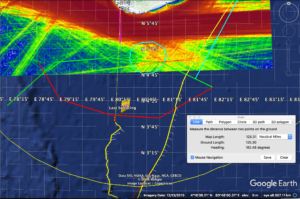
To determine which model is more likely to be correct, we did a test dive with the waypoint straight to the west. The compass heading rose shows the result. The red arrow shows the commanded heading. The light blue bars is a histogram in 30 degree increments of the direction RU29 actually flew. The dark blue arrow is the average heading, indicating we flew 120 degrees to the right of the waypoint, or towards 30 degrees east of north.
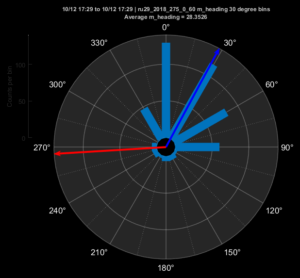
Here we zoom in to the location of RU29 and overlay the Copernicus currents. The glider moved to the northeast, and Copernicus says the currents by the glider are very low.
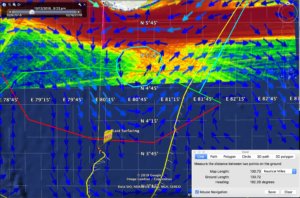
Now we remove the Copernicus currents and overlay the Hycom currents. HYCOM says the currents are strong and to the west. But the glider flew northeast.
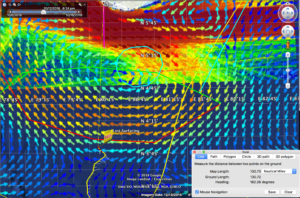
Looks like the Copernicus model is giving us a better result more consistent with the observed glider behavior. Zooming even closer in on copernicus, there is an eddy just to the south of the shipping lanes. The distance from RU29 to the center of the eddy is about 140 km, so again, less than 2 weeks away. If we park there, the distance from Galle to Ru29 will be 66 nautical miles.
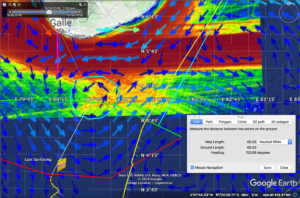
Hope is to bring RU29 a bit farther north than that, and sit at the outer edge of the shipping lanes, only 40 nautical miles from Galle.
-
Time series of near surface temperature from Navy Glider
Posted on October 12th, 2018 No commentsHere we take a time series look at the near surface (2o m depth) temperature reported by the Navy Glider as Hurricane Matthew went by.
The time of eye passage is shown by the vertical dashed line. Temperature increase is at one slower rate until about 05:00 on Oct 10, just before eye passage. We then see a more rapid temperature decrease for about 8 hours, most of which occurs after eye passage. By about 17:00 the near surface temperature starts to increase slowly. So three ocean response time periods.

Next to check the model ….
-
Global Model profiles for Hurricane Michael
Posted on October 12th, 2018 No commentsBelow is the same plot as the Glider CTD data but for the Global Ocean Forecast System (GOFS) 3.1 model. Remarkably similar ocean. Differences are in the details.
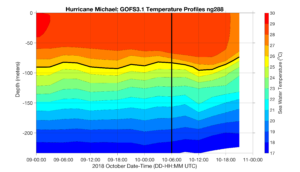
The 26C isotherm here is at a depth of about 90 m. The Navy glider has it at about 110 m, a bit deeper.
Surface layer cooling occurs more slowly in the model.
We will be looking into those details next.
-
Detailed CTD profiles in Hurricane Michael
Posted on October 12th, 2018 No commentsMaria is looking back at the CTD profiles collected during Hurricane Michael as it approached the Gulf Coast. In the figure below we have 2 days of CTD data from October 9 and 10. The 26C isotherm is indicated with a black line. The vertical black line 0n October 10 at 06:00 is the time of eye passage over the glider. The isotherms deepen most rapidly right after eye passage until about 09:00. Surface temperatures over the 2 days start between 29-30C and end between 27-28C.
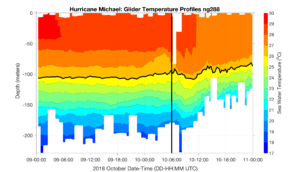
We will look at the time series of temperature at a depth near the surface, like 20 m, soon and get it posted.
-
Navy Glider Temperature and Salinity Profiles during eye passage.
Posted on October 11th, 2018 No commentsIn the previous post, Travis showed the plot of the CTD temperature section from the Navy glider operating just to the right of the path of Hurricane Michael. Here is our first look at the actual Temperature and Salinity profiles that go into that section plot.
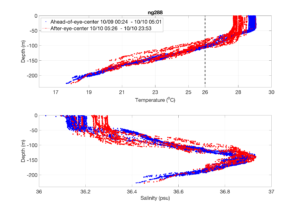
Above we see Maria’s plot of the temperature (top) and salinity (bottom) profiles reported by the Navy glider during the eye passage. Blue is ahead of eye center, red is after eye center. During this time we see a rapid temperature drop of about 1 C, and a deepening of the surface layer from about 50 m to about 90 m. For salinity, we see the salinity of the surface layer increase by about 0.1 psu.
-
Back to Sri Lanka
Posted on October 11th, 2018 No comments
Waypoint is to the southwest, but RU29 is moving northeast, about 180 degrees from the waypoint. Ru29 is about 140 nautical miles south of Galle, the southern most port and the location of our recovery vessel. the red semi-circle is the 120 nautical mile circle from Galle. At 10 knots, this is a 12 hour boat ride from Galle.
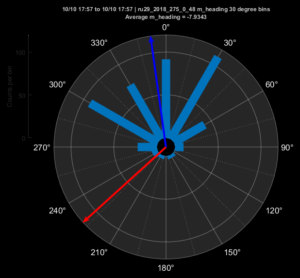
Heading compass rose. Direction to waypoint is in red, to southwest. Histogram of observed heading in 30 degree increments in light blue. Average heading is dark blue arrow, which is almost directly north, or 135 degrees to the right of the commanded heading. But we are not heading north. We are heading northeast. There must be some eastward current.
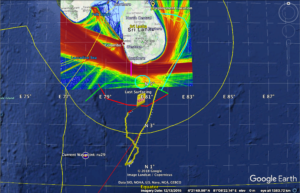
Checking traffic, the busy shipping lane extends around the southern side of Sri Lanka a distance of 40 nautical miles offshore. We don’t want to come any closer than this.
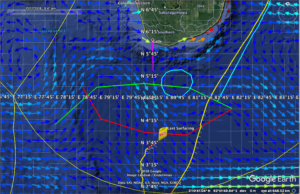
Now we zoom in and look at the currents. First Copernicus. Currents at the glider are to the southeast, so they have an eastward component. Between RU29 and Galle there is a wavy current that runs west to east. There is a low velocity region half way between Ru29 and Sri Lanka circled in cyan. The currents are counterclockwise around this low current region. So a counterclockwise eddy in Copernicus.
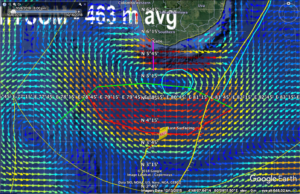
Hycom has an eddy in the exact same place as Copernicus, as seen by the cyan circle. But the circulation around the eddy in hycom is clockwise. The currents at the glider are strong and to the northwest. But the glider needs a current with an eastward component to produce the observed progress to northeast.
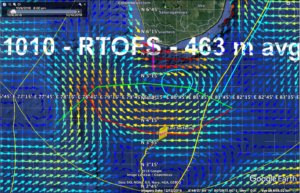
RTOFS has similar results to hycom, with a clockwise eddy between RU29 and Sri Lanka, and strong currents to northwest at the glider.
Looks like the Copernicus model wins today in this location. That means we should move the waypoint to direct our commanded heading to be more towards the south. A waypoint to the south would give us an actual glider flight direction 135 degrees to the right, or towards the northwest. Combine this with the eastward or southeastward currents, and we may get the east-west components to cancel each other, enabling us to make more progress directly to the north.
-
Hurricane Michael cloud tops
Posted on October 10th, 2018 No comments
Above is our usual cloud top image showing the size of Hurricane Michael after making landfall today in Florida. Michael is forecast to take an inland route across the southeast states and cross the Mid Atlantic Bight on its way back out to sea.
-
RAMA Moorings
Posted on September 17th, 2018 No commentsHere is the dogleg track from Sri Lanka to Mauritius. The most northern RAMA mooring on the 81E line is a 4S. We would have to divert to a dues south path to get near it.
The most southern RAMA mooring on the 67E line is at 12 S, right along our intended path.
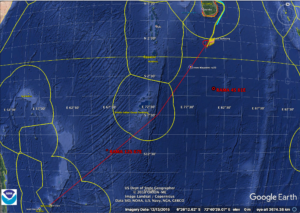
Looks like our fly-by of a RAMA mooring will wait for 12S, 67E.
-
Sept 11 Sentinel Glider Tour
Posted on September 14th, 2018 No commentsA first tour of the Hurricane Sentinel Glider Fleet on Sept 11 as Florence was still approaching and a comparison to the operational models. Note that the data was transmitted over the GTS so it was available for assimilation in the models. All plots were prepared by Maria Aristizabal.
The first picket line is off Africa in the formation zone where the north-south extent is relatively narrow.
TWR Glider SILBO indicates the GOFS models are getting the surface layer quite well. All models miss the colder temperature layer near 100 m, but all are back in good agreement between 150 and 200 m.
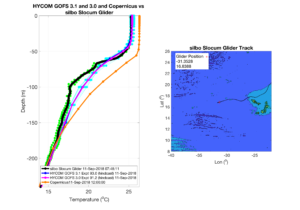
Second picket line. The Caribbean and Tropical Atlantic.
First is the station keeping Navy Glider NG300. GOFS models doing well, especially GOFS 3.1
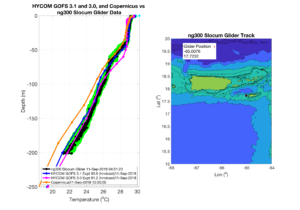
Next is the AOML Glider SG630 occupying the transect south of PR. All models agree well.

Then the third picket line protecting the US Mainland.
Gulf of Mexico first.
Navy Glider NG429 is in deepwater. GOFS models do well in deepwater.
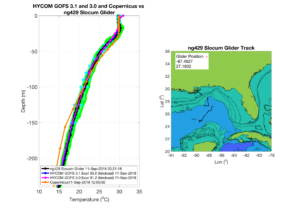
Navy Glider NG288 is on the outer shelf. Not only do GOFS models do well, GOFS 3.1 even matches some of the curves in the profile. Data assimilation might be doing very well here.
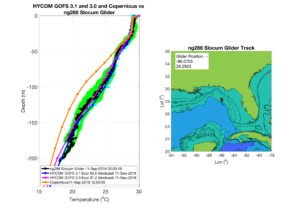
Now South Atlantic Bight
Skidaway Institute of Oceanography glider PELAGIA. We have told this story before. GOFS 3.0 is closest, but it might be for the wrong reasons. GOFS 3.1 is designed to have more vertical resolution in shallow water, and PELAGIA is definitely in shallow water.
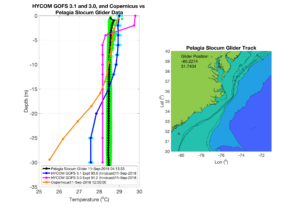
Into the Mid Atlantic Bight.
Here is RAMSES, the UNC glider operated by SIO for the NSF PEACH program. An early favorite in the reporting. Here is where GOFS 3.1 shines bright even in shallow water.
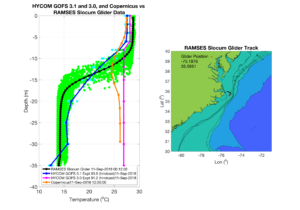
Moving north, we find Rutgers glider RU33 running along the shelf break. We are on the deeper side of the shelf. The Stratification Factor maps showed that both GOFS 3.0 and 3.1 were stratified on the outer shelf, and that is what this comparison demonstrates.
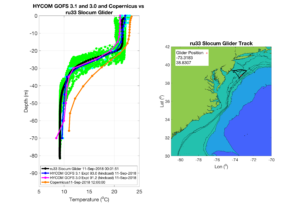
Continuing north to UMass Glider BLUE, we see a complicated structure at mid shelf that no model likes. Copernicus seems to lock onto the profile sooner, near 40 m.
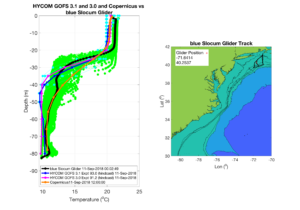
One final step north, we move on to the NSF OOI Coastal Pioneer Glider CP376. Another profile that no model seems to like, even with this glider in deepwater. Surface temperatures are off. GOFS 3.1 is good at getting the near surface variation. Copernicus is good at getting the deep variation.
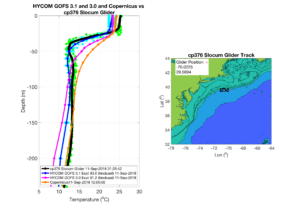
-
Hurricane Glider Picket Lines
Posted on September 13th, 2018 No commentsHere is the evolving figure for the Hurricane Glider Picket Lines. It was just submitted as a placeholder to the OceanObs19 white paper entitled OceanGliders: a component of GOOS. The final figure is due in October. Other suggestions welcomed.
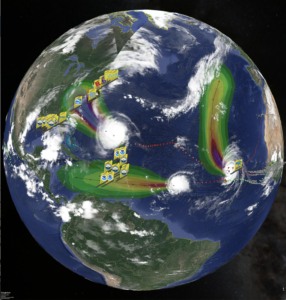
Caption:
Hurricane Florence, Isaac and Helene cloudtops (left to right) on September 11, 2018, with NHC best tracks behind each hurricane, NHC probability of tropical storm force winds ahead of each hurricane, and the tails of the diverse fleet of ocean gliders in the picket lines transmitting upper ocean data in near-real time to forecasters.



